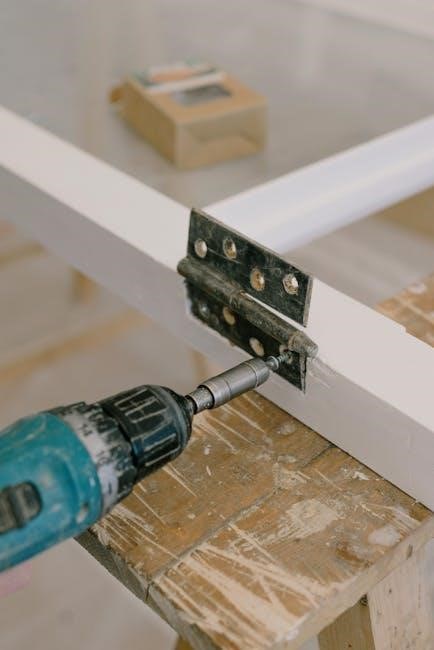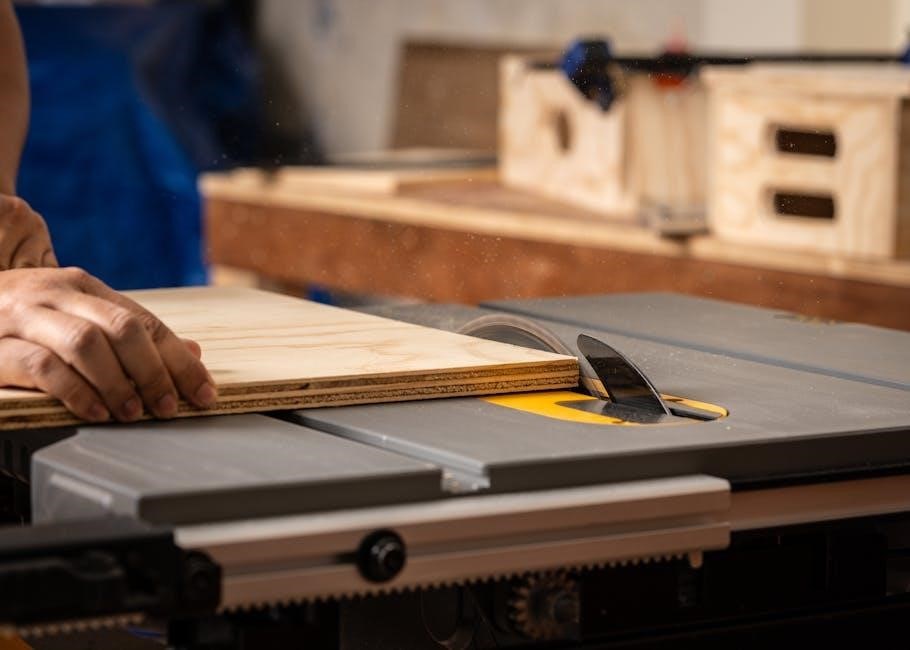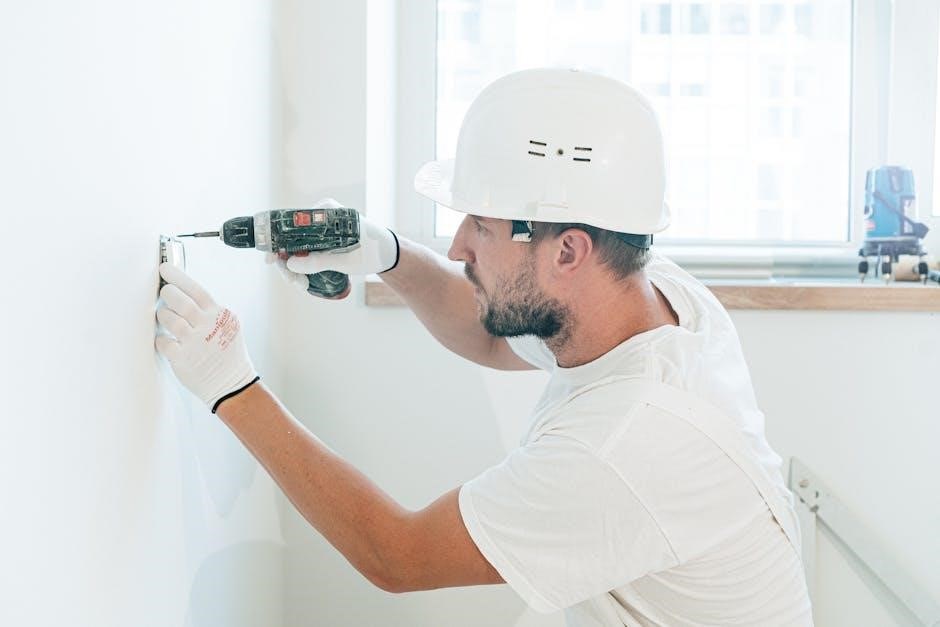Pre-Installation Planning
Before installing the Biamp TCM-XA microphone, ensure the environment is assessed for optimal performance. Verify the room’s acoustics and layout to determine the best placement for 360-degree coverage. Check power requirements, as the TCM-XA is a PoE device needing IEEE 802.3at Class 4 (30W) support. Ensure network infrastructure supports AVB connectivity for seamless integration with Tesira systems. Review the installation manual to confirm all components, such as the plenum box and mounting hardware, are included. Plan cable routes in advance for a clean setup. Proper planning ensures efficient installation and optimal audio performance.

Components and Accessories
The Biamp TCM-XA installation requires several key components and accessories to ensure proper functionality and integration. The primary component is the TCM-XA ceiling microphone itself, which features Beamtracking technology for 360-degree audio coverage. This microphone is designed to work seamlessly with Tesira systems and includes a built-in PoE amplifier, making it a self-contained solution for high-quality audio capture.
The TCM-XA is typically paired with a plenum box, a folded metal enclosure designed for installation above a ceiling or within a ceiling tile. This plenum box is passively cooled and includes a digital signal processing module, ensuring optimal audio performance. Additionally, the plenum box comes with an RJ-45 connector, allowing for the integration of an optional TCM-XEX expansion microphone, which can be added to enhance coverage in larger spaces.
For mounting, the TCM-XA supports multiple installation options, including the TCM-X-FM Flush Mount Kit. This kit enables the microphone to be recessed into the ceiling tile or drywall for a low-profile appearance. The kit also includes a 4mm spacer, which adjusts the LED viewing angle to ensure the status indicators remain visible. The TCM-XA can be installed in a corner where two T-bars meet, using specialized clips provided for this purpose.
The system supports up to two microphones per plenum box, with one TCM-X or TCM-XA serving as the primary microphone and the TCM-XEX acting as an optional expansion unit. This configuration ensures flexibility for varying room sizes and audio requirements. The TCM-XA also features a locate button, which initiates an audible signal to help identify the microphone during setup or troubleshooting. The Amp LED provides visual feedback on the amplifier’s status, with color-coded indicators for power, fault conditions, and network connectivity.
Other essential accessories include the AVB (Audio Video Bridging) cable for connecting the TCM-XA to Tesira systems, such as the Tesira Connect TC-5 or Tesira Forte AVB VT. The microphone’s PoE requirement (IEEE 802.3at Class 4, 30W) must be supported by the network switch or injector to ensure reliable operation. Additional mounting hardware, such as clips and spacers, may be required depending on the specific installation environment.

Mounting the Plenum Box
Mounting the plenum box is a critical step in the installation of the Biamp TCM-XA ceiling microphone system. The plenum box is a folded metal enclosure designed for permanent installation above a ceiling or within a ceiling tile. Proper mounting ensures the microphone’s optimal performance, durability, and aesthetic integration into the room’s design.
Before starting, ensure the installation location meets the environmental and structural requirements. The plenum box should be mounted in a secure, stable area that can support its weight and any additional components, such as the TCM-XA microphone or TCM-XEX expansion unit. If installing in a drop ceiling, verify that the T-bars are sturdy and spaced appropriately to accommodate the plenum box and its mounting hardware.
The TCM-XA plenum box is typically mounted using the provided clips and fittings. For corner installations, specialized clips are available that attach to the notched fittings of the plenum box cover. These clips secure the microphone at the intersection of two T-bars, ensuring a stable and visually appealing installation. For flush-mount installations, the TCM-X-FM Flush Mount Kit is recommended. This kit allows the microphone to be recessed into the ceiling tile or drywall, providing a low-profile appearance. The kit includes necessary spacers and adapters to ensure the microphone sits flush with the surface.
When mounting the plenum box, align it with the ceiling grid or drywall cutout carefully. For drywall installations, mark the cutout area according to the manufacturer’s specifications and use a drywall saw or similar tool to create the opening. Secure the plenum box using the provided hardware, ensuring it is level and firmly attached to prevent movement or vibration, which could affect audio quality.
Once the plenum box is mounted, the TCM-XA microphone can be installed into the box. The microphone is typically secured using a mounting clip or screw, ensuring it is properly seated and aligned. For recessed installations, the 4mm spacer included with the Flush Mount Kit should be placed behind the microphone to bring the LED ring flush with the ceiling surface, maintaining a clean and professional appearance.
After mounting, test the microphone’s position by speaking into it and verifying that the audio is clear and free from echoes or interference. Adjust the microphone’s angle or position if necessary to achieve the best possible sound quality. Properly mounting the plenum box not only ensures the microphone performs optimally but also contributes to the overall aesthetic and functionality of the installation.

Connecting Components
Once the plenum box is securely mounted, the next step is to connect the necessary components to ensure proper functionality of the Biamp TCM-XA microphone system. This step requires careful attention to detail to ensure all connections are secure, properly configured, and meet the system’s requirements.
The TCM-XA microphone system supports AVB (Audio Video Bridging) connectivity, which enables high-quality, low-latency audio transmission over Ethernet networks. To establish this connection, use a Cat5e or higher Ethernet cable to connect the TCM-XA to a Tesira processor or other compatible AVB-enabled devices. Ensure the network infrastructure is configured to support AVB traffic, with appropriate QoS (Quality of Service) settings to prioritize audio streams.
The TCM-XA is a PoE (Power over Ethernet) device, requiring IEEE 802.3at Type 2 Class 4 power. This means the microphone can be powered directly through the Ethernet connection, eliminating the need for a separate power supply. However, verify that the PoE switch or injector used in the installation meets the required power specifications to avoid performance issues or device malfunction.
In addition to the primary microphone connection, the TCM-XA plenum box includes an RJ-45 connector for optional expansion. This allows the integration of an additional TCM-XEX Expansion Ceiling Microphone, which can be connected to the plenum box to provide enhanced coverage in larger or more complex spaces. When using an expansion microphone, ensure it is securely connected and configured according to the manufacturer’s guidelines.
The TCM-XA also features an Amp LED, which provides visual feedback on the status of the amplifier. This LED can indicate power status, connectivity issues, or other system states, making it a valuable tool for troubleshooting. Refer to the installation manual for a detailed explanation of the LED color codes and their corresponding statuses.
After all connections are made, power on the system and verify that the LED indicators on the TCM-XA and any connected components are functioning as expected. Use the locate button to test the audio output and ensure the microphone is picking up sound correctly; If issues arise, check all connections for integrity and ensure the network configuration supports AVB and PoE requirements.
Properly connecting the components is essential for achieving optimal performance from the TCM-XA microphone system. By following the manufacturer’s guidelines and paying close attention to network and power requirements, you can ensure a reliable and high-quality audio experience.
System Configuration
Configuring the Biamp TCM-XA microphone system is a crucial step to ensure optimal performance and integration with existing audio-visual equipment. This process involves setting up the microphone’s advanced features, such as Beamtracking technology, audio processing parameters, and network settings, to tailor the system to the specific requirements of the installation environment.
The TCM-XA microphone is designed to work seamlessly with Biamp’s Tesira family of products, including the Tesira Connect TC-5 and Tesira Forte AVB series. During configuration, the microphone must be discovered and added to the Tesira system using Biamp’s Tesira Software. This software provides a user-friendly interface for configuring network settings, audio routing, and processing parameters. Ensure the latest version of the software is installed to access all features and ensure compatibility.
One of the standout features of the TCM-XA is its Beamtracking technology, which provides 360-degree coverage of the meeting space by dynamically adjusting the microphone’s pickup pattern. During configuration, you can customize the Beamtracking zones to match the specific layout of the room, ensuring that all participants are heard clearly. The microphone supports four 90-degree zones, which can be adjusted to focus on specific areas or expanded to cover the entire space.
Audio processing settings, such as gain, noise reduction, and echo cancellation, can also be configured using the Tesira Software. These settings are critical for achieving high-quality audio output and minimizing background noise or interference. It is recommended to conduct a sound test during configuration to fine-tune these settings and ensure optimal performance in the actual acoustic environment;
In addition to audio settings, network configuration is another important aspect of the setup process. The TCM-XA supports AVB (Audio Video Bridging) for low-latency, high-quality audio transmission over Ethernet networks. Ensure that the network is properly configured to support AVB traffic, with appropriate QoS (Quality of Service) settings to prioritize audio streams. This will help prevent issues such as audio dropouts or synchronization problems.
Once the initial configuration is complete, it is essential to test the system thoroughly to ensure all components are working together as expected. This includes verifying that the microphone is picking up audio correctly, the Beamtracking zones are functioning as configured, and the audio output is clear and free of distortion. Any issues detected during testing should be addressed by revisiting the configuration settings or checking the network and audio connections.
Finally, once the system is fully configured and tested, it is recommended to save the configuration settings and create a backup of the system setup. This ensures that the configuration can be easily restored in case of any future issues or system updates. Regular maintenance and updates should also be performed to keep the system running at peak performance.

Testing and Troubleshooting
Once the Biamp TCM-XA microphone system is installed and configured, thorough testing is essential to ensure it operates as expected. This step verifies that all components are functioning correctly and identifies any potential issues that may require troubleshooting. Proper testing also ensures high-quality audio performance and reliable operation in various meeting scenarios.
Begin by powering on the system and checking the status LEDs on the TCM-XA microphone and associated components, such as the Tesira Connect TC-5 or Tesira Forte AVB. The LEDs provide visual indicators for power, network connectivity, and audio activity. For example, a solid green LED typically indicates normal operation, while a flashing red LED may signal an error or issue that requires attention.
Next, test the microphone’s audio output by speaking into it and monitoring the audio signal through the connected system. Ensure the sound is clear, free of distortion, and properly routed to the intended destinations, such as speakers or recording devices. If the audio quality is poor, check the microphone’s gain settings in the Tesira Software and adjust as needed to optimize the signal-to-noise ratio.
Verify the Beamtracking functionality by moving around the room and ensuring the microphone dynamically adjusts its pickup pattern to maintain clear audio capture. This feature is particularly important in spaces with multiple speakers or varying layouts. If the Beamtracking zones are not performing as expected, review the configuration settings in the Tesira Software and make adjustments to align with the room’s acoustics.
Network connectivity is another critical aspect to test, especially since the TCM-XA relies on AVB (Audio Video Bridging) for low-latency audio transmission. Ensure the Ethernet connections are secure and that the network is properly configured to support AVB traffic. Check for any issues such as dropped packets or synchronization problems, which can be diagnosed using the Tesira Software or network monitoring tools.
If issues arise during testing, refer to the troubleshooting guides provided in the Biamp TCM-XA installation manual. Common problems include incorrect network settings, insufficient power (PoE requirements), or firmware incompatibility. Updating the firmware to the latest version often resolves software-related issues, while physical inspections of cables and connections can address hardware-related problems.
Finally, conduct a comprehensive system test in real-world conditions to simulate typical usage scenarios. This includes testing multiple audio sources, verifying the performance of expansion microphones (e.g., TCM-XEX), and ensuring seamless integration with other components, such as amplifiers or USB devices. Documenting the results of these tests provides a baseline for future maintenance and ensures the system meets the desired performance standards.
By systematically testing and troubleshooting the Biamp TCM-XA system, you can identify and resolve any issues early, ensuring reliable operation and high-quality audio performance for all users.

Safety and Compliance
Ensuring the safe and compliant installation and operation of the Biamp TCM-XA microphone system is critical to prevent hazards, meet regulatory requirements, and guarantee optimal performance. Adhering to safety guidelines and compliance standards is essential for protecting both the equipment and its users.
First, always follow the safety precautions outlined in the Biamp TCM-XA installation manual. Avoid exposing the microphone or associated components to water or excessive moisture, as this can damage the electronics or create electrical hazards. Ensure the system is installed in a well-ventilated area to prevent overheating, which can occur if the plenum box or other components are obstructed.
The TCM-XA is a PoE (Power over Ethernet) device, classified under IEEE 802.3at Type 2 Class 4, requiring up to 30W of power. Ensure the network switch or power source used to power the device meets these specifications to prevent damage or malfunction. Additionally, use only approved Category 5e (or higher) Ethernet cables to maintain reliable connectivity and minimize the risk of electrical issues.
Compliance with local and international regulations is another key consideration. The Biamp TCM-XA is designed to meet global standards for audio equipment, including CE marking for conformity with European Union directives and FCC compliance for use in the United States. Ensure the system is installed in accordance with these regulations to avoid legal or operational issues.
During installation, follow proper lifting and handling techniques to prevent physical strain or damage to the equipment. Mount the plenum box securely in the ceiling or wall to ensure stability and avoid accidents caused by falling components. Use the provided hardware and follow the manufacturer’s instructions for installation to maintain safety and warranty validity.
Environmental considerations are also important. The TCM-XA is designed to operate within a specific temperature and humidity range. Avoid installing the system in environments with extreme temperatures (above 40°C or below 0°C) or high humidity levels, as this can compromise performance and longevity.
Finally, familiarize yourself with the safety warnings and cautions provided in the manual. For example, avoid touching electrical components during installation, and ensure all connections are secure to prevent short circuits. If you are unsure about any aspect of the installation, consult a qualified professional to ensure compliance with safety and regulatory standards.
By adhering to these safety and compliance guidelines, you can ensure the Biamp TCM-XA system operates safely, efficiently, and in accordance with all relevant regulations. Proper safety practices not only protect the equipment but also ensure the well-being of users and maintain the system’s performance over time.

Documentation and Resources
Proper documentation and resources are essential for the successful installation, configuration, and maintenance of the Biamp TCM-XA microphone system. Biamp provides a comprehensive suite of materials to guide users through every step of the process, ensuring optimal performance and ease of use.
The Biamp TCM-XA installation manual is the primary resource for installers and system integrators. This detailed document includes step-by-step instructions for mounting the plenum box, connecting components, configuring the system, and troubleshooting common issues. It also provides technical specifications, such as power requirements (IEEE 802.3at Type 2 Class 4, 30W), network connectivity options (AVB), and compatibility with Tesira systems. By following the manual, users can ensure a smooth and efficient installation process.
Supplementing the manual, Biamp offers product data sheets and system design guides on their official website. These resources provide in-depth technical information, including diagrams, wiring schematics, and best practices for integrating the TCM-XA into various audio setups. For example, the data sheet outlines the microphone’s Beamtracking technology, which provides full 360-degree coverage through four 90-degree zones, ensuring superior audio quality in meeting spaces.
Biamp also provides access to firmware and software updates through their website. Regular updates ensure the system remains up-to-date with the latest features and security patches. Users can download these updates directly from the Biamp support page, ensuring optimal system performance and compatibility with other devices in the Tesira ecosystem.
For troubleshooting and technical assistance, Biamp offers a dedicated support page with FAQs, knowledge base articles, and contact information for their customer support team. If issues arise during installation or operation, users can refer to these resources or reach out to Biamp’s expert technical support for guidance. Additionally, the manual includes a troubleshooting section that addresses common issues, such as LED status indicators and network connectivity problems.
Biamp also provides training resources to help users master the TCM-XA system. These include online courses, webinars, and hands-on training programs designed to familiarize installers and system administrators with the product’s features and capabilities. By leveraging these resources, users can gain a deeper understanding of the system and ensure it operates at peak performance.

Post-Installation Check
After completing the installation of the Biamp TCM-XA microphone system, it is crucial to perform a thorough post-installation check to ensure all components are functioning correctly and the system is operating as intended. This step is essential for verifying the integrity of the installation, identifying any potential issues, and ensuring optimal audio performance.
First, visually inspect all physical connections to confirm they are secure and properly routed. This includes checking the RJ-45 connectors for AVB network connectivity, the power over Ethernet (PoE) connections, and any auxiliary inputs or outputs. Verify that the plenum box is correctly mounted and that the microphone is properly seated to maintain the desired low-profile appearance.
Next, power on the system and observe the LED indicators on the TCM-XA. The LEDs provide critical status information, such as power confirmation, network connectivity, and microphone activity. For example, a solid green LED typically indicates normal operation, while a flashing LED may signal a specific status or error condition. Refer to the installation manual for a detailed explanation of LED behaviors.
Conduct a thorough audio test to ensure the microphone is capturing and transmitting high-quality audio. Use the Beamtracking technology to verify that the microphone is accurately picking up sound from all four 90-degree zones, providing full 360-degree coverage of the meeting space. Test the audio output through the connected AVB-compatible devices, such as the Tesira Connect TC-5 or Tesira Forte AVB VT, to ensure seamless integration and synchronization.
If the system includes multiple microphones or expansion units, such as the TCM-XEX, verify that they are properly synchronized and communicating with the TCM-XA. Test the locate feature, which cycles through connected outputs and flashes the device status LEDs, to confirm that all components are responding correctly. This feature is particularly useful for identifying and troubleshooting individual microphones in a multi-microphone setup.
Finally, review the system configuration to ensure all settings are optimized for the specific application. This includes adjusting gain levels, verifying network settings, and confirming that all firmware and software are up to date. Refer to the Biamp documentation and resources, such as product data sheets and system design guides, for detailed instructions on fine-tuning the system.
A comprehensive post-installation check not only ensures the system is functioning as intended but also helps prevent potential issues from arising during use. By carefully verifying each component and testing the overall system performance, installers can confidently deliver a reliable and high-quality audio solution tailored to the needs of the space.
